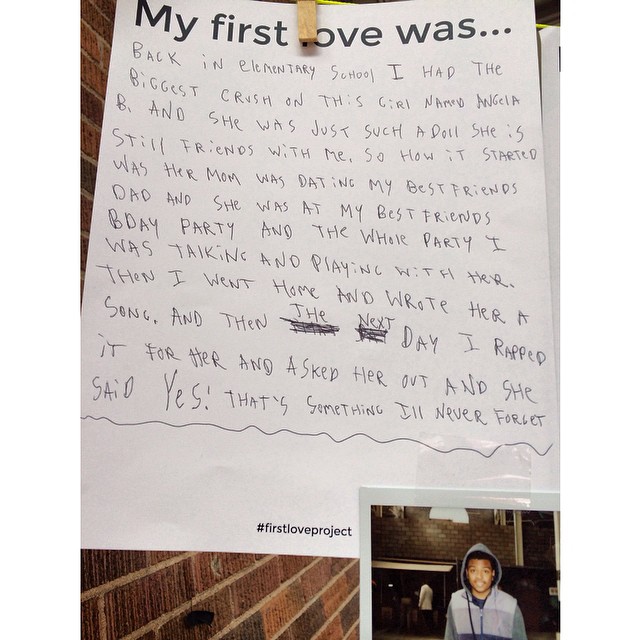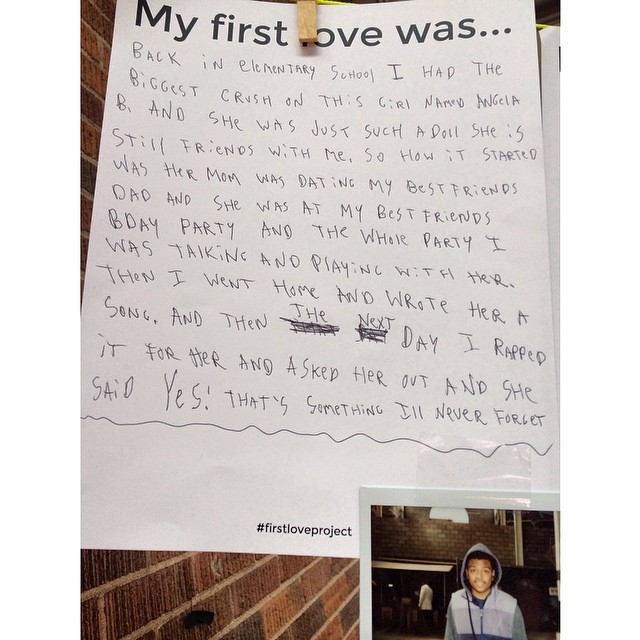
A creative change of conversation in Detroit
Photo: First Love Project installation at Eastern Market. Credit: Hunter Franks.
Hunter Franks, an artist and founder of the Neighborhood Postcard Project and League of Creative Interventionists, is in Detroit for three weeks using creativity to build community with Knight Foundation support.
I could see the stark blue of the sky piercing through the repetitive square windows on all sides of the massive abandoned brick building. The windows were gone, letting light seep in slowly. It was an odd sight, one which I had never seen before — and it was the first thing I saw in Detroit. It is what most people probably know of Detroit. The media has extensively covered the city as a blighted wasteland, and that was indeed what struck me at first. But there are upsides to blight and disinvestment — an opportunity for Detroiters to creatively reimagine their city with shared spaces and opportunities. Related Links
Planned activities for #CreateDetroit tour by Hunter Franks
“The Creative Interventions Tour: Lessons from Macon, Ga.” by Hunter Franks on Knight Blog (4/10/14)
“Breaking down barriers in Akron through shared art experiences” by Hunter Franks (8/6/14)
“Creativity builds new community connections in Philadelphia” by Hunter Franks (7/9/14)
When local Phil Cooley wanted more space for a woodshop, he purchased an available building in Detroit’s Corktown neighborhood. He then opened up the space to Detroiters with a similar desire to grow their small businesses and called it Ponyride. Veronika Scott rented one desk in the corner of a large room at Ponyride when she was launching the Empowerment Plan, a nonprofit that employs homeless women to sew coats that turn into sleeping bags, and then distributes the coats to homeless individuals living on the street. Two years later, she has nearly 20 employees and rents out all of that same large room at Ponyride.
Matt Naimi saw similar opportunities emerge from a lack of infrastructure. Detroit had no citywide curbside recycling program in 2005, so Matt started Recycle Here, a recycling center that invites people to bring their recyclables in. Thousands flock to the Recycle Here warehouse every Saturday to recycle. The center has grown into a shared space, as Saturdays are the only time many of those people see their neighbors, and make new friends in the process.
These examples of reclaiming spaces and activating them into shared spaces continue to inspire others to do the same. It inspired me as well, as I sought out Detroit’s oldest shared space, Eastern Market, to set up my First Love Project. The project collects stories of people’s first love along with a Polaroid portrait of them and then displays those together in public space. Regardless of what we look like or where we come from, we all share the story of a first love. A teenager shared his story of writing a rap song for a girl he had a crush on. Pat, who has been married 26 years, shared the story of how she met her husband and what followed, including spending time apart and caring for her disabled sister. A young lady visiting from Belgium said her first love was her grandfather’s typewriter, full of “sound and story.” Words were Oneita’s first love too, and the former Detroit Free Press columnist filled a full page with her favorite words—from“tantamount” to “xanadu.” Others smiled as they perused the displayed stories, couples embraced, and some were moved to share their own story.
It’s a simple way to start breaking down social barriers, to hear the personal stories of strangers whose stories we normally would not hear. As Detroit changes, and as national media begins to change the conversation about Detroit, I hope to tell the story of the people here, and help them feel more connected in the process. After all, it is the people who make a place.
See more planned activities at www.creativeinterventionists.com/detroit and follow along on social media via #createdetroit.

Recent Content
-
Communitiesarticle ·
-
Communitiesarticle ·
-
Communitiesarticle ·


